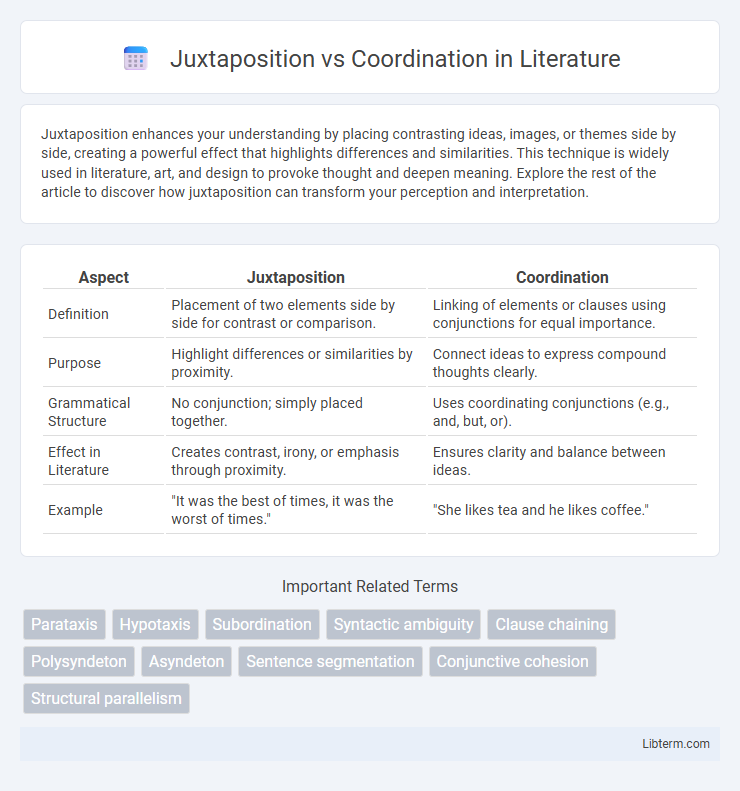Juxtaposition enhances your understanding by placing contrasting ideas, images, or themes side by side, creating a powerful effect that highlights differences and similarities. This technique is widely used in literature, art, and design to provoke thought and deepen meaning. Explore the rest of the article to discover how juxtaposition can transform your perception and interpretation.
Table of Comparison
| Aspect | Juxtaposition | Coordination |
|---|---|---|
| Definition | Placement of two elements side by side for contrast or comparison. | Linking of elements or clauses using conjunctions for equal importance. |
| Purpose | Highlight differences or similarities by proximity. | Connect ideas to express compound thoughts clearly. |
| Grammatical Structure | No conjunction; simply placed together. | Uses coordinating conjunctions (e.g., and, but, or). |
| Effect in Literature | Creates contrast, irony, or emphasis through proximity. | Ensures clarity and balance between ideas. |
| Example | "It was the best of times, it was the worst of times." | "She likes tea and he likes coffee." |
Understanding Juxtaposition: A Definition
Juxtaposition refers to the placement of two or more elements side by side to highlight their differences or create a contrasting effect, often used in literature, art, and rhetoric to deepen meaning. Unlike coordination, which connects elements of equal grammatical importance using conjunctions such as "and" or "but," juxtaposition relies on mere placement without explicit connectors, allowing implicit comparisons or contrasts. Understanding juxtaposition involves recognizing how proximity of ideas or images can provoke thought, emphasize themes, or evoke emotional responses through subtle or stark contrasts.
What Is Coordination in Writing?
Coordination in writing involves connecting two or more independent clauses using coordinating conjunctions such as "and," "but," or "or" to create compound sentences that maintain equal grammatical importance. This technique enhances sentence flow and clarity by linking related ideas while preserving their individual significance. Coordinating conjunctions help to balance ideas and prevent the monotony of short, choppy sentences.
Key Differences Between Juxtaposition and Coordination
Juxtaposition places words or phrases side by side without a connecting conjunction, relying on context to establish relationships, while coordination uses coordinating conjunctions like "and," "but," or "or" to explicitly join elements. Juxtaposition often creates subtle or implicit contrasts and comparisons, whereas coordination clearly signals equal grammatical or semantic relationships between the connected parts. The choice between juxtaposition and coordination affects sentence rhythm, clarity, and emphasis in syntactic structure.
The Role of Structure in Juxtaposition and Coordination
The role of structure in juxtaposition versus coordination determines how ideas are connected and perceived within sentences. Juxtaposition places elements side by side without connectors, creating emphasis through contrast or comparison by relying on parallel structures or punctuation like commas and dashes. Coordination explicitly links clauses or phrases using conjunctions such as "and," "but," or "or," establishing clear relational dynamics that guide interpretation and logical flow.
Effects on Reader Perception
Juxtaposition creates a striking contrast by placing two elements side by side, which heightens the reader's awareness of their differences and encourages deeper reflection. Coordination links ideas of equal importance, promoting balance and clarity without emphasizing contrast, thus making the information easier to process. Juxtaposition often evokes stronger emotional responses and critical thinking, while coordination aims to enhance coherence and flow in the text.
Common Uses in Literature and Rhetoric
Juxtaposition often appears in literature to highlight contrasts between characters, themes, or ideas by placing them side by side, intensifying the reader's perception of differences. Coordination, frequently found in rhetoric, connects ideas or clauses with coordinating conjunctions like "and," "but," or "or," creating balanced, clear, and fluid expressions. Both techniques serve to enhance clarity and impact, with juxtaposition emphasizing contrast and coordination promoting logical relationships.
Visual and Verbal Juxtaposition vs. Coordination
Visual juxtaposition involves placing contrasting images or elements side by side to highlight differences or create new meanings, while visual coordination aligns elements harmoniously for cohesive interpretation. Verbal juxtaposition contrasts words or phrases to emphasize meaning through opposition or unexpected pairing, whereas verbal coordination links words or clauses with conjunctions for balanced and clear expression. Both techniques enhance communication by manipulating the relationship between elements to influence perception and understanding.
Techniques for Effective Juxtaposition
Effective juxtaposition techniques involve placing contrasting ideas, images, or elements closely to highlight differences and create a stronger impact on the audience. Utilizing spatial proximity and sharp contrasts in tone, color, or theme enhances the clarity and memorability of each juxtaposed component. Strategic placement and alignment ensure the viewer's focus shifts naturally between elements, maximizing interpretive depth and emotional resonance.
Strategies for Clear Coordination
Effective strategies for clear coordination revolve around using coordinating conjunctions such as "and," "but," and "or" to link clauses of equal grammatical rank, ensuring clarity and logical flow in sentences. Proper punctuation, including the use of commas before coordinating conjunctions, plays a crucial role in distinguishing coordinated elements and preventing ambiguity. Employing parallel structure within coordinated phrases further enhances readability and reinforces the relationship between ideas.
Choosing Between Juxtaposition and Coordination
Choosing between juxtaposition and coordination depends on the clarity and flow desired in a sentence. Juxtaposition places two elements close together without a conjunction, creating emphasis through contrast or comparison, while coordination connects elements with conjunctions like "and" or "but" to show relationships more explicitly. Effective writing balances these methods by using juxtaposition for stylistic impact and coordination for clarity and grammatical structure.
Juxtaposition Infographic

 libterm.com
libterm.com